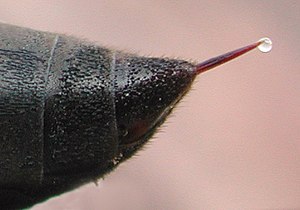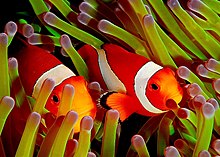Venom

Venom or zootoxin is a type of
Venom has evolved in terrestrial and marine environments and in a wide variety of animals: both
Venoms are often complex mixtures of toxins of differing types. Toxins from venom are used to treat a wide range of medical conditions including thrombosis, arthritis, and some cancers. Studies in venomics are investigating the potential use of venom toxins for many other conditions.
Evolution
The use of venom across a wide variety of
Mechanisms

Venoms cause their biological effects via the many toxins that they contain; some venoms are complex mixtures of toxins of differing types. Major classes of toxin in venoms include:[7]
- serine proteases.[8]
- Neurotoxins, which primarily affect the nervous systems of animals, such as ion channel toxins. These are found in many venomous taxa, including black widow spiders, scorpions, box jellyfish, cone snails, centipedes and blue-ringed octopuses.[9]
- Myotoxins, which damage muscles by binding to a receptor. These small, basic peptides are found in snake (such as rattlesnake) and lizard venoms.[10][11][12][13]
- Cytotoxins, which kill individual cells and are found in the apitoxin of honey bees and the venom of black widow spiders.[14][15]
Taxonomic range
Venom is widely distributed taxonomically, being found in both invertebrates and vertebrates, in aquatic and terrestrial animals, and among both predators and prey. The major groups of venomous animals are described below.
Arthropods
Venomous arthropods include spiders, which use fangs on their chelicerae to inject venom, and centipedes, which use forcipules — modified legs — to deliver venom, while scorpions and stinging insects inject venom with a sting. In bees and wasps, the stinger is a modified ovipositor (egg-laying device). In Polistes fuscatus, the female continuously releases a venom that contains a sex pheromone that induces copulatory behavior in males.[16] In wasps such as Polistes exclamans, venom is used as an alarm pheromone, coordinating a response from the nest and attracting nearby wasps to attack the predator.[17] In some species, such as Parischnogaster striatula, venom is applied all over the body as an antimicrobial protection.[18]
Many
Bees synthesize and employ an acidic venom (
Other invertebrates

There are venomous invertebrates in several
Vertebrates
Fish
Venom is found in some 200 cartilaginous fishes, including
Amphibians
Some salamanders can extrude sharp venom-tipped ribs.[28][29] Two frog species in Brazil have tiny spines around the crown of their skulls which, on impact, deliver venom into their targets.[30]
Reptiles
Some 450 species of snake are venomous.
Venom is found in a few other reptiles such as the Mexican beaded lizard,[35] the gila monster,[36] and some monitor lizards, including the Komodo dragon.[37] Mass spectrometry showed that the mixture of proteins present in their venom is as complex as the mixture of proteins found in snake venom.[37][38] Some lizards possess a venom gland; they form a hypothetical clade,
Mammals
Euchambersia, an extinct genus of therocephalians, is hypothesized to have had venom glands attached to its canine teeth.[40]
A few species of living mammals are venomous, including
Extensive research on platypuses shows that their toxin was initially formed from gene duplication, but data provides evidence that the further evolution of platypus venom does not rely as much on gene duplication as was once thought.[44] Modified sweat glands are what evolved into platypus venom glands. Although it is proven that reptile and platypus venom have independently evolved, it is thought that there are certain protein structures that are favored to evolve into toxic molecules. This provides more evidence of why venom has become a homoplastic trait and why very different animals have convergently evolved.[13]
Venom and humans
Envenomation resulted in 57,000 human deaths in 2013, down from 76,000 deaths in 1990.[45] Venoms, found in over 173,000 species, have potential to treat a wide range of diseases, explored in over 5,000 scientific papers.[36]
In medicine, snake venom proteins are used to treat conditions including thrombosis, arthritis, and some cancers.[46][47] Gila monster venom contains exenatide, used to treat type 2 diabetes.[36] Solenopsins extracted from fire ant venom has demonstrated biomedical applications, ranging from cancer treatment to psoriasis.[48][49] A branch of science, venomics, has been established to study the proteins associated with venom and how individual components of venom can be used for pharmaceutical means.[50]
Resistance
Venom is used as a trophic weapon by many predator species. The coevolution between predators and prey is the driving force of venom resistance, which has evolved multiple times throughout the animal kingdom.[51] The coevolution between venomous predators and venom-resistant prey has been described as a chemical arms race.[52] Predator/prey pairs are expected to coevolve over long periods of time.[53] As the predator capitalizes on susceptible individuals, the surviving individuals are limited to those able to evade predation.[54] Resistance typically increases over time as the predator becomes increasingly unable to subdue resistant prey.[55] The cost of developing venom resistance is high for both predator and prey.[56] The payoff for the cost of physiological resistance is an increased chance of survival for prey, but it allows predators to expand into underutilised trophic niches.[57]
The
The kingsnakes of the Americas are constrictors that prey on many venomous snakes.[61] They have evolved resistance which does not vary with age or exposure.[55] They are immune to the venom of snakes in their immediate environment, like copperheads, cottonmouths, and North American rattlesnakes, but not to the venom of, for example, king cobras or black mambas.[62]

Among marine animals, eels are resistant to sea snake venoms, which contain complex mixtures of neurotoxins, myotoxins, and nephrotoxins, varying according to species.[63][64] Eels are especially resistant to the venom of sea snakes that specialise in feeding on them, implying coevolution; non-prey fishes have little resistance to sea snake venom.[65]
Clownfish always live among the tentacles of venomous
See also
- Schmidt Sting Pain Index
References
- ^ "venom" at Dorland's Medical Dictionary
- ^ )
- PMID 16924809.
- ^ "Poison vs. Venom". Australian Academy of Science. 3 November 2017. Retrieved 17 April 2022.
- ^ Nelsen, D. R., Nisani, Z., Cooper, A. M., Fox, G. A., Gren, E. C., Corbit, A. G., & Hayes, W. K. (2014). "Poisons, toxungens, and venoms: redefining and classifying toxic biological secretions and the organisms that employ them". Biological Reviews, 89(2), 450-465. doi:10.1111/brv.12062. PMID: 24102715.
- PMID 11164036.
- PMID 15316044.
- PMID 9504137.
- PMID 16716265.
- S2CID 20601072.
- S2CID 45019479.
- PMID 1862521.
- ^ PMID 18463304.
- S2CID 21796492.
- PMID 28587399.
- S2CID 32612635.
- S2CID 38398672.
- S2CID 206185438.
- PMID 20114060.
- PMID 26805882.
- S2CID 23234351.
- ^ Frost, Emily (30 August 2013). "What's Behind That Jellyfish Sting?". Smithsonian. Retrieved 30 September 2018.
- ISBN 978-3-319-40615-2.
- ^ Gallagher, Scott A. (2 August 2017). "Echinoderm Envenomation". EMedicine. Retrieved 12 October 2010.
- PMID 17932414.
- ^ Barry, Carolyn (17 April 2009). "All Octopuses Are Venomous, Study Says". National Geographic. Archived from the original on 30 September 2018. Retrieved 30 September 2018.
- ^ PMID 16740627.
- ^ Venomous Amphibians (Page 1) – Reptiles (Including Dinosaurs) and Amphibians – Ask a Biologist Q&A. Askabiologist.org.uk. Retrieved on 2013-07-17.
- JSTOR 1443606.
- S2CID 13606620.
- ISBN 978-1-4027-3181-5.
- ^ "Snake Bites". A. D. A. M. Inc. 16 October 2017. Retrieved 30 September 2018.
- PMID 25079342.
- S2CID 4286612.
- S2CID 24722441.
- ^ a b c Mullin, Emily (29 November 2015). "Animal Venom Database Could Be Boon To Drug Development". Forbes. Retrieved 30 September 2018.
- ^ PMID 19451641.
- ^ Fry, B. G.; Wuster, W.; Ramjan, S. F. R.; Jackson, T.; Martelli, P.; Kini, R. M. 2003c. Analysis of Colubroidea snake venoms by liquid chromatography with mass spectrometry: Evolutionary and toxinological implications. Rapid Communications in Mass Spectrometry 17:2047-2062.
- S2CID 4386245.
- PMID 28187210.
- PMID 24074353.
- PMID 22410495.
- ^ Jørn H. Hurum, Zhe-Xi Luo, and Zofia Kielan-Jaworowska, Were mammals originally venomous?, Acta Palaeontologica Polonica 51 (1), 2006: 1-11
- PMID 22285376.
- PMID 25530442.
- PMID 12974396.
- ^ Holland, Jennifer S. (February 2013). "The Bite That Heals". National Geographic. Archived from the original on 25 May 2018. Retrieved 30 September 2018.
- PMID 29510162.
- ISBN 9789400766495.
- PMID 23578513.
- S2CID 11196041.
- S2CID 9695900.
- )
- S2CID 24103.
- ^ PMID 27444525.
- PMID 28219972.
- PMID 23266311.
- PMID 3672545.
- ISSN 0005-7959.
- PMID 27122552.
- OCLC 1423604.
- S2CID 53706054.
- JSTOR 1446808.
- PMID 9643474.
- PMID 1529461.
- PMID 23122007.
- ^ Fautin, Daphne G. (1991). "The anemonefish symbiosis: what is known and what is not". Symbiosis. 10: 23–46 – via University of Kansas.
- PMID 19268681.
- ISBN 978-3-319-31305-4
- PMID 24878777.
- PMID 7801342.
- S2CID 86114704.
- ^ PMID 25274370.


